Menu
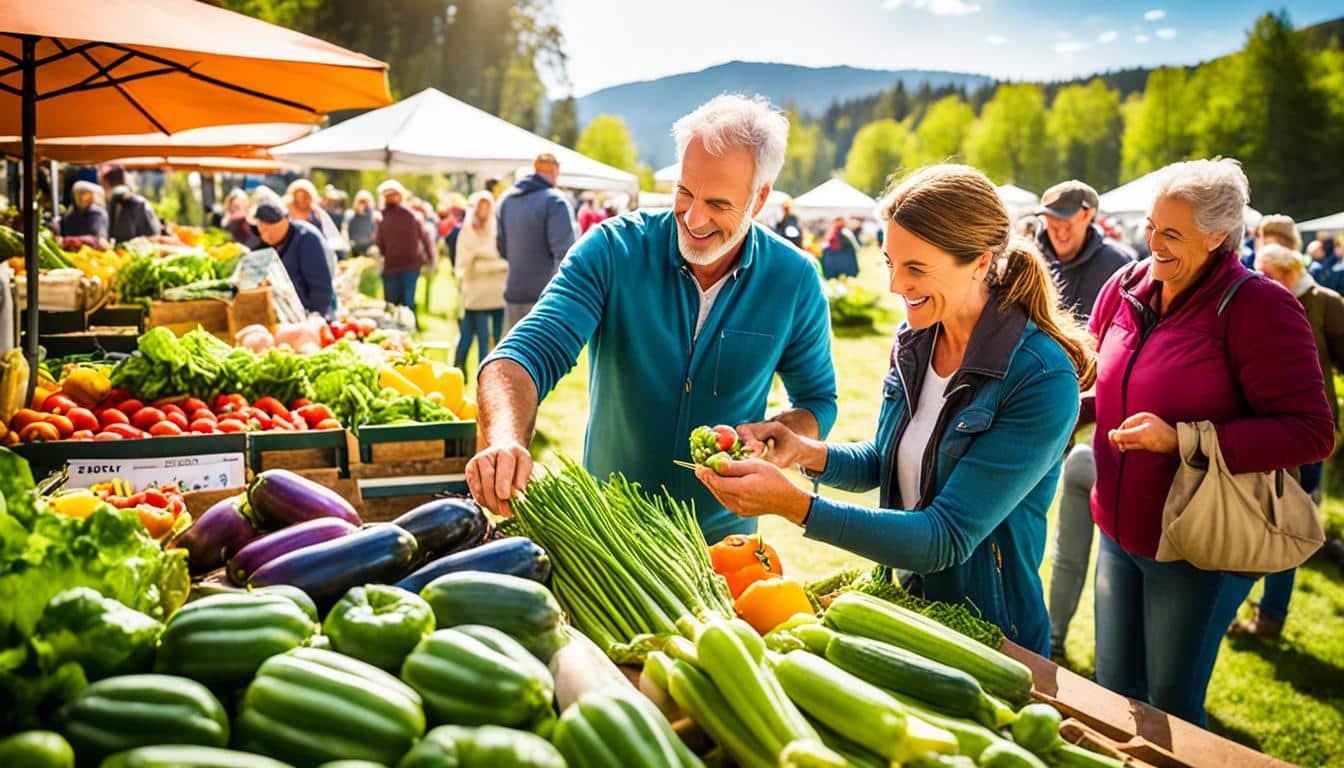
Did you know that according to late 2018 data, there was a 67% surge in outdoor activity picks by travellers? This jump shows that more people are interested in agritourism, seeking unique experiences in the countryside. Selling in agritourism is more than just selling a product. It’s about showing and telling the story of these special adventures. Whether picking your own produce or staying on a farm, the way you market these rural experiences matters.
Many agritourism sites are only open part of the year. It’s important for them to create an unforgettable visit. One that guests will share on social media and recommend to friends. A good marketing plan must meet the business goals and offer what customers are seeking. Telling the story of the experience is key. This approach helps make the marketing efforts of agritourism more successful.
A marketing strategy is key for an agritourism business to do well in sustainability farming tourism. It helps to show off the amazing experiences and green initiatives you offer. This method is about knowing what customers want and making sure you provide it.
For agritourism, it’s crucial to have clear marketing goals. Setting out what you want to achieve, like more farm visits or higher sales, is the start. These aims must match your business’ bigger dreams and be SMART. In 2018, 67% more travellers chose outdoor activities, showing a rise in rural interest. This is important for setting your goals.
Building a solid marketing plan means doing your homework first. Research and analyse deeply. Your plan should set out goals, strategies, budgets, and ways to check if it’s working. It all starts with understanding your audience. Knowing who they are and what they like helps ensure your farm suits their needs. Cooking classes and historical tours saw big jumps in bookings, proving the power of varied activities.
Marketing and promoting your venture needs serious money. Allocating 10 to 30 percent of your income is wise. This keeps visitors coming and improves how appealing your farm is. Getting funding from sources like the Southern Regional Risk Management Education Center stresses the need for smart finances in agritourism.
In agritourism marketing, knowing your audience is crucial for success. Understanding who you’re selling to lets you make marketing that really connects with them. The key parts of figuring this out are demographics, psychographics, and where they are located.

Demographics look at basic info like age, gender, and family size. It also checks income and education. All this tells us what different groups might like. For example, Forbes found a big rise in people enjoying outdoor and cultural activities, so we know it’s a good spot to focus our efforts.
Psychographics is about how people think and feel, not just who they are. It digs into their values and interests. This info is great for making our messages hit home, especially for those who love eco-friendly or cultural things. It’s clear from a jump in cooking classes’ popularity that hands-on experiences mean a lot to some.
Geographic segmentation is all about where people are. It tells us what they might like based on their area. Whether it’s a city or the countryside, knowing local interests helps a lot. For instance, folks in some places might love learning about new cultures, so marketing cultural trips there could be a hit.
| Segmentation Type | Key Factors | Insights |
|---|---|---|
| Demographic | Age, Gender, Income, Education, Family Status | Align offerings with specific interests like outdoor activities. |
| Psychographic | Values, Interests, Lifestyles | Appeal to motivations for interactive and experiential travel. |
| Geographic | Location, Population Density, Regional Preferences | Tailor marketing strategies to regional trends and cultural preferences. |
We create detailed customer profiles using all this info. It helps our marketing be on point and impactful. This approach enhances our reach and encourages people to come back, making our agritourism efforts a success.
A good agritourism business uses the marketing mix well. This means focusing on the product you offer, where it’s located, its price, and how you promote it. By getting these elements right, your agritourism will offer exactly what your customers want.
To succeed, it’s all about the product, place, price, and promotion:
Adapting to what different people like is key. For example, more travellers are choosing outdoor and foodie activities. By offering cooking classes or nature tours, you meet this demand.
Knowing your visitors’ details, like age and where they’re from, really helps. Plus, using social media is a must. Since so many people are online, these platforms are great for getting your message out.
In the end, knowing your market and tailoring your approach is crucial. This way, your business not only gets noticed but also keeps customers happy and coming back.
Bringing a great customer experience is key for agritourism places to do well. By mixing learning with real farm life, you can win over guests. This lets them make fond memories and want to come back.
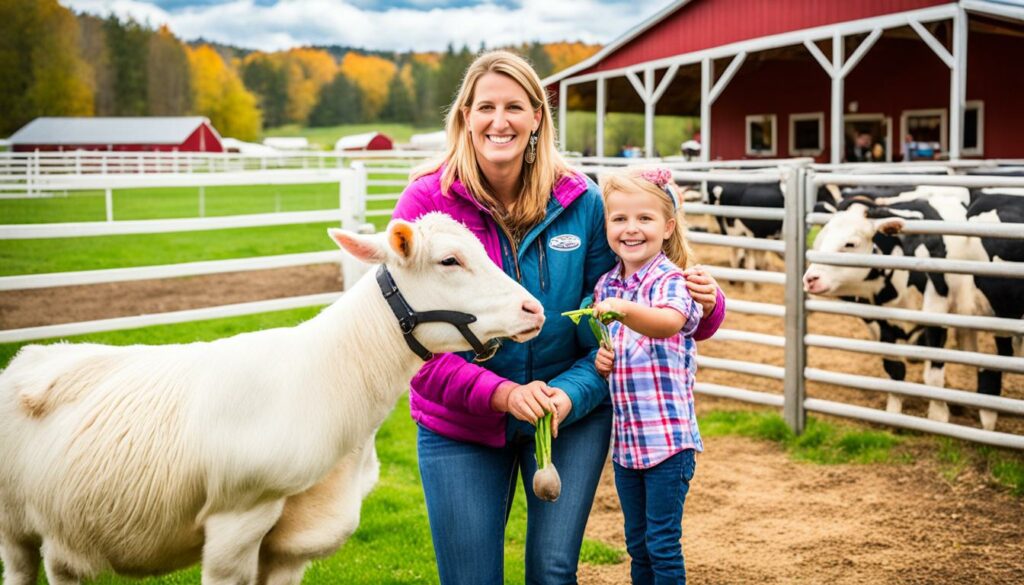
To make it real, add many farm activities. Forbes says more travellers picked outdoor and cultural stuff in 2018. This shows people love getting their hands dirty and being part of the action. Let them pick their own food, show them around the farm, and teach them how to cook to meet their needs.
Top-notch service is a must in agritourism. It’s shown that good training for your team makes all the difference in how guests feel. A warm welcome and keeping things safe and easy to get to also are important. Your place needs to be up to scratch and follow the rules. This way, guests feel happy and secure and are likely to come back and tell others about you.
| Aspect | Increase in Activity (2018) |
|---|---|
| Outdoor Activities | 67% |
| Cooking Classes | 61% |
| Cultural Excursions | 59% |
Doing these things makes your farm visit better for guests. It also boosts your place’s image and keeps them coming back.
To succeed in agritourism marketing, you need strategic elements. Make sure your farm’s activities are real and teach visitors something. To make nature-based agri-tourism promotions work, we offer top-notch service. We train our team to keep customers happy.
Safety and easy access are key in our marketing plan. Forbes noted a 67% jump in outdoor activities in late 2018. More and more people want outdoor fun that’s well managed and safe.
Building goodwill and backing green agrotourism help our farm stand out. A strong community and green activities boost our image and help the earth. More cooking and cultural classes are being booked, showing varied experiences are a hit.
Using YouTube, Facebook, Instagram, and Pinterest is a must. By January 2019, 90% of adults in the U.S. were online. Being active and creative online is crucial to attract visitors to our farm.
Having a solid marketing budget is crucial for our financial health. It lets us spend well on ads and other promotions. We study our visitors’ likes and tailor our ads. This way, we connect better with families, school groups, or adventurers.
In the end, every guest’s experience must be great. Happy visitors tell others about us. We focus on what guests say and keep improving. This is the heart of our marketing success.
In today’s world, digital marketing is vital for agritourism success. With a strong online presence, you can grab your audience’s attention better. This will help you reach more people and keep them coming back. We’ll look at making your website better, using social media wisely, and running email campaigns.
Making your website better is key in agritourism marketing. You need to make sure it works well for users and is easy to find on search engines. Here’s what you should focus on:
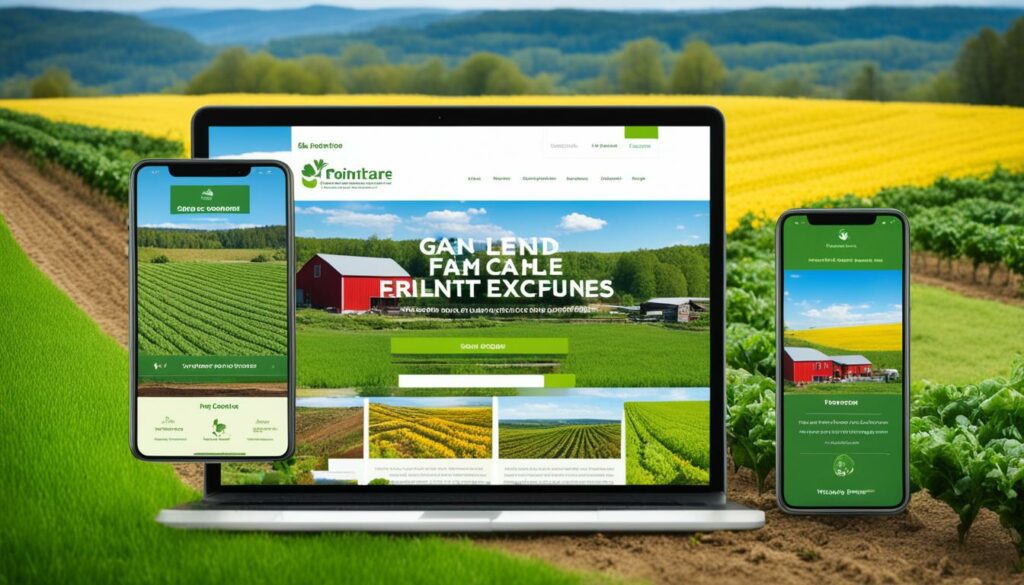
It’s also smart to learn about your visitors and use that to make their visit more personal. This can boost how much they enjoy their time and even spend with you.
Being active on social media helps you connect with more people. By sharing exciting stories and experiences, you can get them interested and coming to visit. Here are some tips:
Top social media sites like YouTube and Instagram are great for connecting with people. They let you share your stories with a wide audience.
Using emails well is crucial in digital marketing for agritourism. By sending the right messages to the right people, you can bring visitors back. Here’s what to focus on:
Sharing positive feedback from others can also help build trust with future visitors. It encourages more people to visit again and again.
To make the most of digital marketing, you need a mix of the right tech, great content, and always checking how your efforts are doing. This way, agritourism places can get their message across strongly and win the hearts of their target audience.
Grasping the natural season changes in agritourism is key to good marketing. This method mixes planning for high-season and appealing to customers in the low season. By doing this, you create a full plan to keep visitors coming and the business thriving year-round.
During busy times, it’s vital to be seen and draw in as many people as possible. Forbes says, TripAdvisor’s 2018 info found a 67% jump in people choosing outdoor fun over the previous year. This underlines the need to make the most of popular times by throwing exciting, well-advertised events.
Farm stays, picking your own produce, and themed tours are all the rage. They jumped in popularity by 59%. So, focus on these during peak times to pull in the crowds.
Keeping folks interested when fewer visit is just as vital. But with smart thinking, you can still connect with them. For example, using social media, which 72% of US adults use, can spark new excitement with cooking lessons or deep dives into culture that were a hit in 2018.
Using these web tools keeps the audience hooked on your place all year.
New off-season activities and smart digital marketing can keep interest all year. Having a varied range and clever adverts can make the slow times a golden chance.
Below is a summary table of key strategies for busy and quiet times:
| Strategy | Peak Season | Off-Season |
|---|---|---|
| Activity Focus | Outdoor and Cultural Experiences | Cooking Classes, Digital Engagement |
| Marketing Channels | Event Promotions, Social Media | Email Campaigns, Online Content |
| Customer Engagement | High Visibility, Special Offers | Virtual Events, Personalised Updates |
This method highlights how careful planning in the busy times and thinking outside the box in the slow times is what makes agritourism marketing work. It’s a full strategy to keep your business buzzing and attractive every day.
Sustainable farming tourism is now a key part of Californian agriculture. It brings environment-friendly initiatives to visitors. This change is pushing organic farming and conservation forward. Each year, over 2.4 million people join in these activities in California.

This kind of tourism greatly helps small farms. The USDA says 68% of these farms are small with less than $250,000 in sales a year. They use environment-friendly strategies to boost profits and cut their impact. Around 75% say tourism helps them earn more.
The wine industry in California shows how tourism and green farming can work together. It draws 21 million visitors a year who spend around $2.1 billion. This brings big money in, but there are hurdles like permits and health rules. These can slow down how much tourism can grow.
Institutions like UC SAREP play a big role in supporting sustainable tourism. They’ve helped over 2,000 farmers learn about agritourism in special workshops. Plus, UC’s studies and research offer key info for the industry. This all leads to better and stronger support for green tourism in California.
Green tourism isn’t just a fad; it’s critical for the future. By mixing eco-friendly methods and genuine tourism, it supports farming’s future. It also helps visitors connect deeply with nature.
Strong community bonds and relationships with local businesses are keys to successful agritourism marketing. These connections help build a good image and attract and keep customers.
Business collaboration in agritourism benefits everyone involved. It opens up chances for joint promotion, resource sharing, and better visitor experiences. Working with local eateries on farm-to-table meals or with artisans on fairs can increase your audience.
According to reports, joining efforts with local businesses can use Facebook well. Around 69% of US adults use Facebook. This means you can reach more people, expanding your customer base.
Hosting events like festivals, workshops, and tours brings your community closer. These events create lasting friendships and a sense of community. Forbes also found that more people are choosing outdoor and cultural activities. This shows growing interest in such events.
These activities not only bring fun but also teach about sustainable farming and local history. This is an excellent way to share knowledge.
In Oklahoma, agritourism had a $64 million impact in 2017. Talking about your events on social media and local news helps your community get involved. This boosts the success of your events.
| Benefits of Community Events | Examples |
|---|---|
| Enhanced Local Community Engagement | Seasonal Festivals, Farm Tours |
| Educational Opportunities | Workshops on Sustainable Farming |
| Economic Impact | Increased Visitor Spending |
| Mutual Promotions | Collaborations with Local Artisans |
Focusing on community engagement and teamwork with local businesses boosts agritourism ventures. By blending these approaches in their marketing, operators create a lively, supportive community around their business.
Creating good agritourism pricing strategies means knowing many things. Key is understanding the cost structure. This includes fixed and variable costs. Knowing this helps set prices that meet financial goals and market needs.
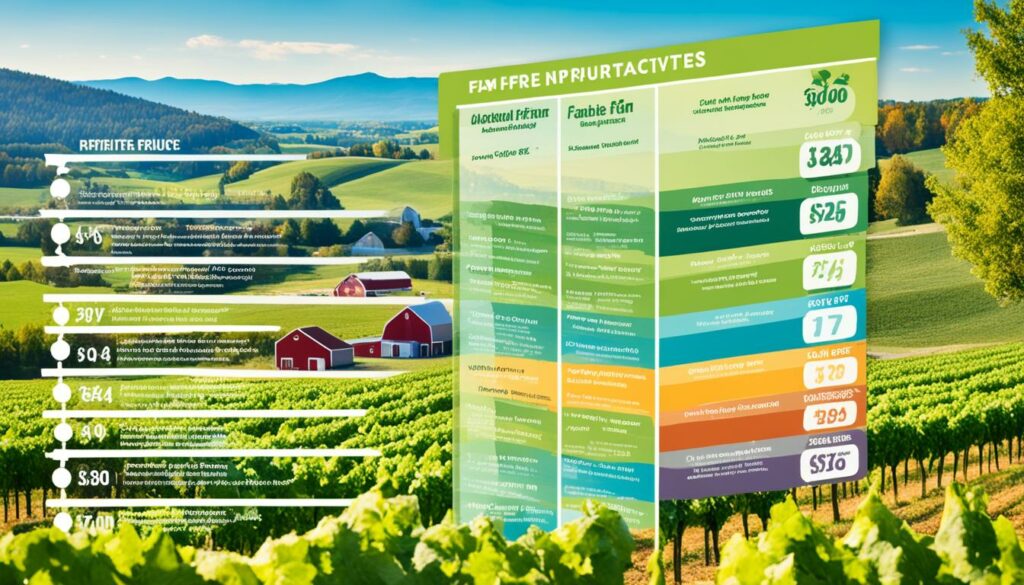
It’s crucial to analyse costs carefully to make good pricing plans. This means looking at fixed costs, like rent, and variable costs, for example, seeds. Checking costs regularly is wise. It ensures your prices are right. Also, see what your competitors are charging to avoid price battles and keep your prices fair.
Value-based pricing in agriculture focuses on what makes your agritourism special. It looks at what customers think and values. By emphasising what makes your farm or rural trips unique, you can price well. These strategies meet customer expectations and boost your business’s image.
| Pricing Method | Description | Benefits | Considerations |
|---|---|---|---|
| Cost-Plus Pricing | Adding a fixed margin to the production cost | Simplicity, clear profit margins | May not reflect market demand accurately |
| Competitive Pricing | Setting prices based on competitors’ rates | Helps stay relevant in the market | Risk of price wars |
| Value-Based Pricing | Pricing based on perceived customer value | Captures customer satisfaction and perceived quality | Requires thorough market understanding |
| Dynamic Pricing | Adjusting prices based on demand and inventory | Maximises revenue during high demand periods | Can lead to customer dissatisfaction if not managed well |
| Bundle Pricing | Selling multiple items together at a discount | Encourages larger purchases | May reduce profit margins per item |
| Psychological Pricing | Setting prices just below a whole number | Influences customer perception | Less effective if overused |
By using a variety of pricing methods and always checking costs, agritourism businesses can do well. They do this by understanding costs and using smart pricing strategies. This helps connect with the people they want to reach and makes a profit.
Adding eco-friendly promotions to agritourism marketing makes farms more attractive. It also meets the demand for green choices from consumers. Green marketing helps businesses show their support for the environment. It builds a positive public image too.
Using green marketing in agritourism makes your farm stand out. By highlighting eco-friendly activities like organic farming, you make your farm memorable. Forbes notes a 67% rise in outdoor activity choices in 2018. This shows more people want nature-based experiences.
These methods attract eco-aware travellers and improve your farm’s image with everyone.
Talking about your sustainability efforts can really help your brand. With so many people online and on social media, sharing your green work there is key. Facebook, Instagram, and Pinterest are great places to tell people about your eco-friendly practices.
For instance, Facebook reaches over 2 billion people monthly. This can help you share your eco-friendly work widely. You can share interesting stories and posts about your sustainable practices:
In Oklahoma, agritourism farms have done well with active social media. Their original posts get more likes than just simple information. Plus, promoted pages see more interaction. This shows how important it is to engage with the public and talk about your green efforts.
By marketing sustainability, you can increase visitors and help the environment. It spreads awareness about the importance of taking care of our planet.
Storytelling lets agritourism businesses form special bonds with their customers. They can do this by sharing stories that show the farm’s background, values, and what makes it unique. This helps them stand out from others and keeps customers coming back.
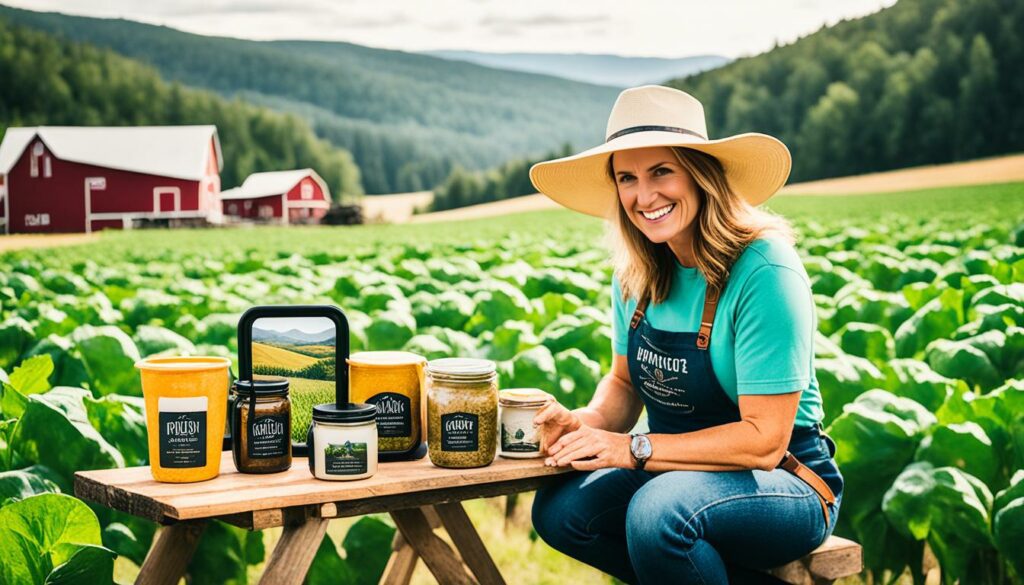
In Franklin County, Massachusetts, farmers make over $2 million each year selling directly to customers. This highlights the power of telling great stories about their farm. These stories can be about how the farm began, its challenges, and its successes.
By telling these tales, small farms make visits memorable for their guests. This is especially true for visitors over 25 who live in cities and have good incomes. Farm stories turn regular visits into something special, creating strong connections.
It’s also important to let customers share their own stories about the farm. This can be through social media. For example, 86% of people who visit rural places are looking for leisure. This makes agritourism a big draw.
When customers share happy experiences, it helps your brand reach more people and build trust. Using stories from real people enhances your brand story. This makes your brand more interesting and believable.
Telling stories the right way boosts the draw of agritourism. It attracts tourists looking for one-of-a-kind experiences. By creating your own stories and letting visitors share theirs, you build strong, meaningful connections. This leads to more visits and ongoing success.
Making agritourism sites safe and accessible is crucial. It’s both a law and key to great visitor experiences. Good agritourism spots keep facilities well kept and follow safety rules. This lets everyone enjoy the visit, no matter their abilities.
Keeping up with maintenance is a must to be safe. This means meeting zoning, health, food, and environment rules. It’s smart for agritourism sites to have a plan to spot and fix any dangers. Good customer service helps too, as staff can quickly handle issues.
Making farms easy to visit means more than just legal requirements. It’s about designing places so everyone can get around easily. Following the ADA is very important for this. Clearly marked areas, paths that are easy to walk, and good restrooms welcome all visitors.
Doing these things not only meets safety rules but also makes places more welcoming to all. It attracts a variety of people. Those who take good care of their places and make them easy to visit set a great example for farm tourism.
In today’s fast-paced business world, keeping an eye on marketing efforts is key to success in agritourism. It’s vital to use reliable metrics for ongoing improvement in this complex sector.
Identifying and using key performance indicators is crucial in agritourism marketing. KPIs like website visits, how visitors engage, sales rates, and customer happiness are essential. They help measure the success of marketing plans.

Understanding KPIs fully shows that being specific is very important. For instance, checking how people interact on social media helps see post impact. Looking at email open and click rates evaluates how emails are doing. KPIs offer details on what customers like and how they act. This info helps agritourism spots improve what they offer.
Using cutting-edge analytic tools for marketing makes tracking simpler. Google Analytics, HubSpot, and SEMrush are just a few examples. They give deep analysis so businesses can see what visitors do, find trends, and meet market needs well.
In 2018, there was a big rise in outdoor activities and cultural trips, showing more people are interested. With this knowledge, marketing strategies can address this interest better. Sites like YouTube, Facebook, Instagram, and Pinterest are key. Almost all U.S. adults were online by January 2019, with most using social media.
At last, blending analytic tools into marketing shows clearly how well campaigns are doing. This approach allows companies to make smart choices based on data. Therefore, marketing efforts can be more flexible, focused, and effective in attracting and keeping loyal visitors.
In conclusion, good agritourism marketing is about carefully planning your approach. This means knowing who your audience is and mixing in the right marketing methods. By learning about your customers, you can create experiences they’ll love. This helps build strong connections and encourages people to visit again.
Using the internet, like websites and social media, can help you reach more people. In Colorado, for example, farms made a lot more money between 2002 and 2007 because of agritourism. So, using digital tools is key to your success.
Another big factor is the growing interest in outdoor activities. In 2018, there was a 67% jump in people booking outdoor trips. This shows just how profitable it can be to offer various activities. To stay ahead, it’s important to work closely with the community. This can boost local support and help spread the word about your business.
Being eco-friendly and ensuring safety are also vital for a successful agritourism venture. It shows your customers that you care about the environment and their well-being. Sharing stories about your business can create a deeper connection with visitors. It’s a powerful way to get people talking about you.
Regularly checking how well your marketing is working is also crucial. That way, you can make changes as needed to keep attracting visitors. By following these steps, you can ensure your agritourism venture thrives. It’s all about creating a strong and lasting impression with your marketing.
The best approaches for marketing in agritourism focus on offering genuine experiences. Exceptional customer service is key. It’s also crucial to keep your place safe and welcoming. All of this makes visitors want to come back and share their good times.
Being part of the community and forming strong local bonds also make a big difference in reaching out.
For your marketing goals, start by knowing your aims and how to meet what customers want. You might aim to get more visitors or highlight special times of the year. Clear, measurable goals are important. They help make a strong, clear marketing plan and let you see what works or not.
To make a marketing plan, first, know who you want to visit. Think about your products, location, the price you charge, and how you promote them. Having a budget and a strategy is essential.
Choosing eco-friendly ways to promote what you offer shows you care about the environment.
Understand who might come by looking at age, income, and where they live. Knowing what’s important to them and what they like is a big help. This makes sure you market to the right people the right way.
The marketing mix means carefully choosing what you offer, where, at what price, and how you tell people about it. Doing this well helps match what you offer to different types of visitors. It also makes your place really stand out among others in the countryside.
To make visitors’ time great, offer real, fun farm activities and excellent service. Always keep your place safe and easy to navigate. This not only means more visits but also good words shared about you which help a lot.
The best digital ways to market include a great website, smart uses of social media, and interesting emails. These let you show off what’s great about your place, keeping people interested and making your name known online.
Think about what makes each season special and plan big things for those times. This can be special events or deals. But don’t forget the quiet times; still, offer something to keep people engaged and coming back.
Initiatives for sustainable tourism focus on being good to the environment. This includes farming in an eco-friendly way and caring for nature. Doing these things makes visitors’ time better while looking after the planet and the local community.
Get involved with local businesses and run events for the community. This makes people like you more, which is good for attracting and keeping customers. It also helps everyone in the area.
When setting prices, think about your costs, who your visitors are, and what your place offers. It’s also about making sure your prices match what people expect and see the value in what you give them.
Promote your place using ways that are gentle to the planet. This matches with what many care about now. It also shows that you’re serious about being eco-friendly, which can draw in like-minded visitors.
Stories are a great way to tell people what makes your farm special. This might be about your history, what you stand for, or great visits others have had. Sharing these makes a real connection with your audience.
Keeping your place safe and easy to get around is crucial. Make sure everything is up to health and safety standards, and that everyone can visit without problems. Doing this makes sure all guests feel welcome and have a great time.
To see how well you’re doing, look at important signs and use tools that show what works online. This helps spot what’s popular and not, so you can always improve what you do to keep visitors happy.